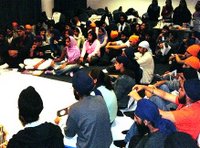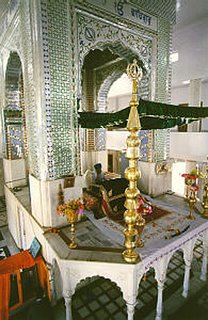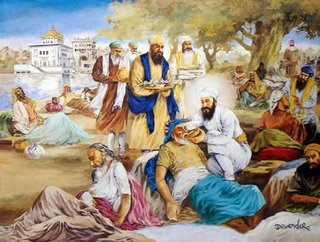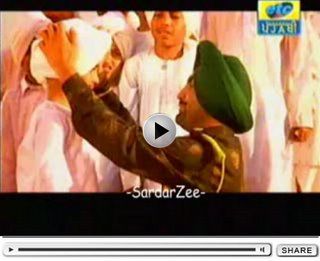Last Saturday was Bhaji Satpal Singh & Bhenji Harmeet Kaur's wedding. Before the Anand Kaaraj, Bhai Davinder Singh Panesar (from Midlands) gave a short talk on the significance, meanning and value of the Anand Kaaraj and the Laavaa(n) da Paath (the four marriage vows). Pressed by time, Bhai Sahib summarised the Anand Kaaraj and the four Laavaa(n) in a nutshell, which was short and sweet.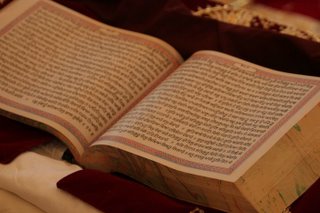
Here's a summary of what Bhai Davinder Singh Panesar said:
Anand Kaaraj, the Sikh wedding ceremony, is about the INNER-JOURNEY of the self and soul, explaining the four stages of Spiritual Development of the individual beings, leading them to Divine Union with their True Self within. However, when translating the marriage vows into English, we translate it and interpret it on a worldly level to match our world-perspective. It's about the SOUL (Aatma) and WAHEGURU (Parmaatma). We are told that the teaching of Gurbani (the Sacred Scriptures) is the sacred basis upon which the sanctity of marriage is to be recognised by people. Thus, marriage in Sikhi is a sacramental knot under the roof of TRUE LOVE, tied in the presence of TRUTH and DIVINITY.
Blessings of Shabad Guru (Divine Infinite Wisdom enshrined in the Word) - that is the main focus of Sikh way of marriage. The Laavaa(n) consist of four verses, which makes up four rounds of the inner-journey and building a relationship with our soul to Waheguru. Getting married, both husband and wife embrace this journey. Husband and wife are "SANGAT," company, who walk together on the path to Waheguru and enjoy the bliss, peace and contentment that one gets from this path.
The First Laav (verse):
ਹਰਿ ਪਹਿਲੜੀ ਲਾਵ ਪਰਵਿਰਤੀ ਕਰਮ ਦ੍ਰਿੜਾਇਆ ਬਲਿ ਰਾਮ ਜੀਉ ॥
har pehilaRee laav, parvirtee karam driR-aa-i-aa bal raam jee-o.
In the first round of the marriage ceremony, Waheguru sets out His Instructions for performing the daily duties of married life.
In this first verse, the first vow, Guru Sahib gives us guidance of how we can EXPERIENCE the Divine, how we experience the Supreme Infinite Lord Waheguru. The next line shows us that we can have this EXPERIENCE through DHARAM.
ਬਾਣੀ ਬ੍ਰਹਮਾ ਵੇਦੁ ਧਰਮੁ ਦ੍ਰਿੜਹੁ ਪਾਪ ਤਜਾਇਆ ਬਲਿ ਰਾਮ ਜੀਉ ॥
baaNee brahmaa ved Dharam driRHu, paap tajaa-i-aa bal raam jee-o.
Instead of the hymns of the Vedas to Brahma, embrace Dharam (the righteous way of life), and renounce sinful actions.
What is DHARAM? Is it religion? Not quite. DHARAM is a WAY OF LIFE. Just as water being wet is insperable, Dharam is that way of life, which becomes insperable and a part of person. Guru Sahib's not interested in us being a "SUNDAY SIKH," who comes to the Gurdwara on Sunday, does Matha Tekh and eat Langar, and that's his "religious Sikh thing" done for the week. DHARAM is a WAY OF LIFE. If you wish to EXPERIENCE the Divine, and experience SUKH (peace) then one has to live a certain way of life, which is living in the remebrance, meditation and grace of Waheguru.
FOUR TYPES OF SIKHS
There are four types of Sikhs. To illustrate this point, let's use the example of a fire.
1/ The first type of person knows through his or her FIRST-HAND EXPERIENCE that by putting one's hand in the fire, it will burn. So they experience the heat of the fire and learnt that it would do them harm. This is like the first type of Sikh -
one whose Sikhi is based on EXPERIENCE of the Guru (Gurbani) and Simran.2/ The second type of person knows that fire will burn their hand, because of another's experience. Therefore, person 2 BELIEVES in person 1, and on the basis of this BELIEF he or she keeps away from fire. This is like the second type of Sikh -
one whose Sikhi is based on BELIEF in what they have been told about Guru Sahib and Sikhi.3/ The third type of person does knows fire is dangerous and not to touch it because person 2 told them that person 1 had experienced the fire. Therefore, person 3 has BLIND FAITH in person 2, and basis his BELIEF on someone else's belief. This is like the third type of Sikh -
one whose Sikhi is based on BLIND-FAITH and they plod along and follow Sikhi because so and so told so and so, and this got passed down.4/ The fourth type of person does not go near fire, not knowing why and thinks its a tradition of the ancestors not to touch fire. Therefore, person 4 follows BLIND-RITUALISM. Not going near fire becomes a RITUAL with no meaning or understand. This is like the fourth type of Sikh -
one whose Sikhi is based on BLIND-RITUALISM and they do things, e.g. Matha Tekh, read Paath, or go the Gurdwara NOT KNOWING "WHY" and carry out these acts because their ancestors andprevious generations did this.What type of Sikhs are we today? Sadly, most of us fall into Sikh no. 4. Hence, Gurbani shows us HOW TO HAVE AN EXPERIENCE. We don't rely on experience of others, rather Gurbani shows us how we can experience Waheguru and Sukh also.
ਹਰਿ ਦੂਜੜੀ ਲਾਵ ਸਤਿਗੁਰੁ ਪੁਰਖੁ ਮਿਲਾਇਆ ਬਲਿ ਰਾਮ ਜੀਉ ॥
har doojRee laav, satgur purakh milaa-i-aa bal raam jee-o.
In the second round of the marriage ceremony, the Lord lead you to meet the True Guru, the Primal Being.
ਨਿਰਭਉ ਭੈ ਮਨੁ ਹੋਇ ਹਉਮੈ ਮੈਲੁ ਗਵਾਇਆ ਬਲਿ ਰਾਮ ਜੀਉ ॥
nirbhau bhai man ho-e, hau-mai mail gavaa-i-aa bal raam jee-o.
With the Fear (awe) of Waheguru, the Fearless Lord Waheguru in the mind, the filth of egotism is eradicated.
In the Second Laav Guru Jee stressed that in forming any relationship you need the quality (ਗੁਣ) of living in fear of your Loved one. What does fear mean? It does not mean FEAR in the BIBLICAL sense, where God curses people and gets angry. No! Fear means that you love the beauty of flowers so much that you FEAR to harm them and you FEAR to damage them. Guru Jee tells us to build a relationship on Love through which fear takes birth, fear in the sense of awe, respect and being humble. Gurmat does not believe in LOVE born in FEAR (as propagated by certain other belief-systems). Through this our EGO will depart and we can live in harmony in our inner-house and outer-house. Washing away our EGO husband & wife can live in harmony and build a relationship with Waheguru.
ਹਰਿ ਤੀਜੜੀ ਲਾਵ ਮਨਿ ਚਾਉ ਭਇਆ ਬੈਰਾਗੀਆ ਬਲਿ ਰਾਮ ਜੀਉ ॥
har teejRee laav, man chaa-o bhe-i-aa bairaagee-aa bal raam jee-o.
In the third round of the marriage ceremony, the mind is filled with Divine Love.
ਸੰਤ ਜਨਾ ਹਰਿ ਮੇਲੁ ਹਰਿ ਪਾਇਆ ਵਡਭਾਗੀਆ ਬਲਿ ਰਾਮ ਜੀਉ ॥
sant janaa har mel har paa-i-aa, vadbhaagee-aa bal raam jee-o.
Meeting with the humble Saints of the Lord, I have found the Lord Waheguru, by great good fortune.
The third Laav emphasises that through living DHARAM and washing away one's EGO, the mind is filled with Love. Love does not come with marriage, Love grows with marriage. Through the SANGAT, through the support of Godly people, we are able to sing, reflect and contemplate on Gurbani, the Divine Treasure of Peace. Guru Sahib doesn't want us to live like Hermits or still secluded from people. The Gurmukh is instructed to sit and join the company of the Saints and through this one obtains strength, support and inspiration.
ਹਰਿ ਚਉਥੜੀ ਲਾਵ ਮਨਿ ਸਹਜੁ ਭਇਆ ਹਰਿ ਪਾਇਆ ਬਲਿ ਰਾਮ ਜੀਉ ॥
har chautaRee laav, man sehaj bhe-i-aa har paa-i-aa bal raam jee-o.
In the fourth round of the marriage ceremony, my mind has become peaceful; I have found the Lord, Waheguru.
ਗੁਰਮੁਖਿ ਮਿਲਿਆ ਸੁਭਾਇ ਹਰਿ ਮਨਿ ਤਨਿ ਮੀਠਾ ਲਾਇਆ ਬਲਿ ਰਾਮ ਜੀਉ ॥
gurmukh mili-aa subhaa-e, har man tan meethaa laa-i-aa bal raam jee-o.
As Gurmukh, I have met Him, with intuitive ease; the Lord Waheguru seems so sweet to my mind and body.
The last and fourth laav talks about the last part of the inner journey, which both husband and wife commit to and travel together on. Through DHARAM, through washing away our EGO and living in LOVE & FEAR of our Waheguru, and through the SAADH SANGAT (company of the holy) one is filled with ecstasy and bliss. This is happiness! Through the Laavaa(n) Guru Sahib shows us the basic ingredients of a Blissful and Happy marriage between husband and wife, and between the couple and Waheguru.
Note: You can download an audio on the practical meaning of Anand Kaaraj, why should we get married and guidance for new couples from a lecture given by Prof. Darshan Singh, translated by Bhenji Navleen Kaur at the Guru Granth Sahib Academy, Toronto:
Prof Darshan Singh - Anand Kaaraj (Audio)
 Kalpana's father was a Hindu, however the family have devotion (shardaa) for the House of Guru Nanak. Bhai Sahib asked Kalpana's father to share something about Kalpana's life with him. He replied that she did Nitnem (daily prayers) every morning (as well as being a vegetarian). The family were fortunate enough to have darshan (glimpse) of the late Baba Nand Singh jee in Uttaranchal. Baba jee had an affect on the family and since then they have practised Nitnem and had love for Gurbani.
Kalpana's father was a Hindu, however the family have devotion (shardaa) for the House of Guru Nanak. Bhai Sahib asked Kalpana's father to share something about Kalpana's life with him. He replied that she did Nitnem (daily prayers) every morning (as well as being a vegetarian). The family were fortunate enough to have darshan (glimpse) of the late Baba Nand Singh jee in Uttaranchal. Baba jee had an affect on the family and since then they have practised Nitnem and had love for Gurbani. Her father said that he had an opportunity to visit the NASA centre at San Jose, America (in September 2004). During his visit he was shown a volume of an English translation of Guru Granth Sahib jee kept at the NASA library. Her father was told that when scientists get tired of searching and searching the universe, when they seek inspiration and need to uplift their souls they turn to read the translations of Guru Nanak's poetry and divine-songs which magnificently describe the awe and wonder of the Universe. There is no other poetry, no other divine-song, no other Scripture, such as the Bani of Guru Nanak Sahib Ji -- Guru Granth Sahib jee.
Her father said that he had an opportunity to visit the NASA centre at San Jose, America (in September 2004). During his visit he was shown a volume of an English translation of Guru Granth Sahib jee kept at the NASA library. Her father was told that when scientists get tired of searching and searching the universe, when they seek inspiration and need to uplift their souls they turn to read the translations of Guru Nanak's poetry and divine-songs which magnificently describe the awe and wonder of the Universe. There is no other poetry, no other divine-song, no other Scripture, such as the Bani of Guru Nanak Sahib Ji -- Guru Granth Sahib jee.









